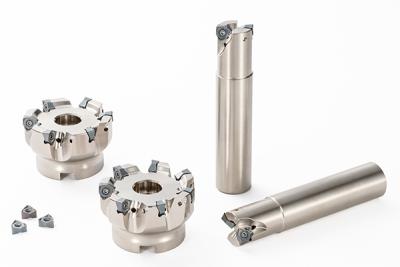
Introducing a smaller, economical diameter range for the M-SIX (MFWN) series milling cutters. The additional cutter designs feature a smaller 5mm D.O.C. insert size with the same cost-efficient, double-sided, 6-edge design from the M-SIX line.
Face Mills: ø50mm ~ ø125mm
End Mills: ø25mm ~ ø80mm
The M-Six double-sided, 6-edge insert milling cutters with tough cutting edge due to wide design.
Advantages
- Sharp Cutting with Low Cutting Forces
Low cutting forces due to steep rake angle. (A.R. Max+13°) - Reduced Chattering
Even with extended milling adapters - Superior Fracture Resistance
8.5mm~5mm thick cutting edge with stable clamping due to unique face design - Neutral Inserts
Available for shouldering and facing with neutral inserts applicable for left-hand cutters (custom order). - MFWN-Mini
Smaller diameters now available with the new MFWN-Mini lineup expansion.
Face Mills: ø50mm ~ ø125mm
End Mills: ø25mm ~ ø80mm
Contact Details
Related Glossary Terms
- gang cutting ( milling)
gang cutting ( milling)
Machining with several cutters mounted on a single arbor, generally for simultaneous cutting.
- milling
milling
Machining operation in which metal or other material is removed by applying power to a rotating cutter. In vertical milling, the cutting tool is mounted vertically on the spindle. In horizontal milling, the cutting tool is mounted horizontally, either directly on the spindle or on an arbor. Horizontal milling is further broken down into conventional milling, where the cutter rotates opposite the direction of feed, or “up” into the workpiece; and climb milling, where the cutter rotates in the direction of feed, or “down” into the workpiece. Milling operations include plane or surface milling, endmilling, facemilling, angle milling, form milling and profiling.
- rake
rake
Angle of inclination between the face of the cutting tool and the workpiece. If the face of the tool lies in a plane through the axis of the workpiece, the tool is said to have a neutral, or zero, rake. If the inclination of the tool face makes the cutting edge more acute than when the rake angle is zero, the rake is positive. If the inclination of the tool face makes the cutting edge less acute or more blunt than when the rake angle is zero, the rake is negative.
